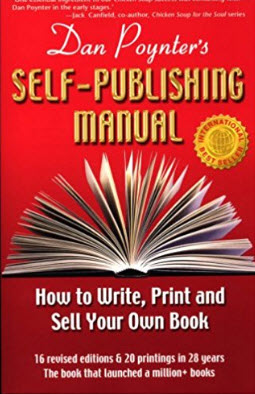How to Price a Book
by Dan PoynterBook pricing depends more upon genre or category than on production costs. Here is a formula for determining how to price your book: You must look at price from the bottom up and from the top down.
Bottom up The Traditional Method (8x)
Bottom up: You must price your book at least eight times (8x) the printing and trucking-in costs. This is your delivered production cost.
Do not include the prepress (design, typesetting and layout) costs in your calculation. These are one-time charges that should be written off. In days past, we used to mark-up both prepress and production costs 8x, but those costs have been considerably reduced because of the computer-publishers can set their own type now, cutting down on some of the prepress expenses. Besides, your book will be around a long time; you will be able to spread those costs over many printings.
"Neither the customer nor the retailer knows or cares what it costs to print the book. They only know what it is worth to them." -Roger PondWhy eight times? Because of distribution and promotion costs. If you charge less than the 8x mark-up, you won't have enough money to promote the book.
 Click here for ordering information. |
Promotion is also expensive, and it is normal to invest 20 to 30% of the gross back into the process of selling your book. Depending upon the subject matter and the size of the potential audience, we often send out more than 500 review copies to appropriate magazines, newsletters, newspaper columns and opinion molders. Reviews are the most effective and least expensive promotion you can do for your book. Review copiess are inexpensive promotion but they are books not sold.
Top Down The Additional Method
Top down: The price you put on your back cover, imbed in your bar code, put on the order blank on the last page of your book and list in all your promotion should be as much as the market will bear. Visit a bookstore and check out the prices of other books like yours.
"Retail price is established by the marketplace not by the cost of production." -Jerrold Jenkins, The Jenkins Group.Yes I know your book has "no competition"; all authors think their book is unique. Buyers do have a choice. And don't fall into the trap of thinking your book is for everyone. For instance, I publish books on skydiving. I would like everyone to jump out of a plane-to have fun, to skydive safely and to come back, make more jumps, join the club, buy equipment and (hopefully) buy more books. But, I am realistic. I know skydiving is not for everyone. (I am not sure why because gravity makes falling easy). Just because you spent the last year pouring your heart, soul and credit limit into your tome, that does not mean everyone is interested enough to buy it and read it. Now, that said, realistically determine the profile of the potential purchaser for your book.
Visit a bookstore and look for other books on your subject that would be purchased by the same type of person. Also look at the formats of those books: shape, color of paper, and types of binding.
You want to find what your potential buyer is willing to spend. If you are selling to teenagers, your price will have to be low and softcover. If yours is a business book, $34.95 and hardcover with a dust jacket may be right. If this is a professional book aimed at doctors, lawyers or accountants, a hardcover book without a jacket at $90 would not be out of line.
Please do not call and ask me how much you can charge for your book. For books on book promotion (such as The Self-Publishing Manual) and for books on parachutes (such as The Parachute Manual), I can make an educated guess. I do not know your field or your customers. I would have to visit a bookstore and check the shelves. You must do the same.
"Prices should be based upon market factors first. What is the customer willing to pay for this product?" -Roger PondIf you poll bookstore managers on pricing, remember that lower prices will sell more books, so they will often advise a lower price.
You do not have any control over the top-down price. Your cover price must be right in the middle of those sitting nearby on the shelf. Customers will compare. If the cover price is too high, you will price your book out of the market and it won't sell. If it is too low, the book will not be credible and potential buyers will think there is something wrong with it. You also won't make enough to invest in further promotion.
Often, you will be surprised what people will pay for your book. There are many examples of people who raised the prices of their books and actually ended up selling more. But, in these cases the buyer was somehow convinced of the value and benefit of the book.
Compare. Hopefully, your bottom-up price (8X) positions lower than your top-down price. If there is an overlap, you will have to reformulate the design of your book. In other words, cut back the size, leave out color photographs or use less-expensive materials.
Pricing your book is not hard. Calculate your costs and visit a bookstore. Do your homework.
Dan Poynter, the Voice of Self-Publishing, has written more than 100 books since 1969 including Writing Nonfiction and The Self-Publishing Manual. Dan is a past vice-president of the Publishers Marketing Association. For more help on book publishing and promoting, see http://ParaPub.com.


